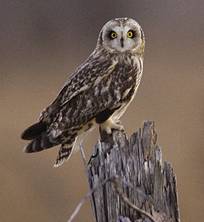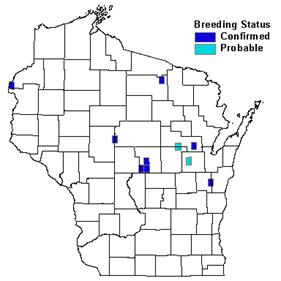Photo by Dennis Malueg


Status/Protection
- Global Rank: G5 Key to global and state ranks
- State Rank: S1B
- WBCI Priority: SGCN, PIF, State Special Concern
Population Information
The Federal BBS information can be obtained at http://www.mbr-pwrc.usgs.gov/bbs/bbs.html by clicking on Trend Estimates and selecting the species in question. All estimates are for time period (1966-2005).
*Note: There are important deficiencies with these data. These results may be compromised by small sample size, low relative abundance on survey route, imprecise trends, and/or missing data. Caution should be used when evaluating this trend.
- Federal Breeding Bird Survey: significant decline
- Federal Breeding Bird Survey (WI): NA
- Federal Breeding Bird Survey (BCR 23): NA
- Federal Breeding Bird Survey (BCR 12): non-significant increase*
- WSO Checklist Project: stable (1983-2007)
Life History
- Breeding Habitat: Idle Cool-season Grasses, Idle Warm-season Grasses, Dry-mesic Prairie, Wet-mesic Prairie, Wet Prairie, Grassland-shrub, Northern Sedge Meadow and Marsh, Southern Sedge Meadow and Marsh, Open Bog-Muskeg.
- Nest: Ground nest, with concealing vegetation (Ehrlich et al. 1988).
- Nesting Dates: Eggs: Late April to mid-May (WSO 1995).
- Foraging: Low patrol and swoops (Ehrlich et al. 1988).
- Migrant Status: Short-distance migrant, Neotropical migrant.
- Habitat use during Migration: Same as breeding habitat, although smaller habitat patches may be used (Holt and Leasure 1993).
- Arrival Dates: Early March to early May (Robbins 1991).
- Departure Dates: Early October to late November (Robbins 1991).
- Winter Range: Southern Canada south to the Gulf Coast and Mexico (Holt and Leasure 1993).
- Winter Habitat: Open areas including grasslands, marshes, meadows, woodland openings, crop stubble, ag fields, some shrubby thickets (Holt and Leasure 1993).
Habitat Selection
The Short-eared Owl nests in open grassland, tundra, oldfield, sedge meadow, hayfields, and other areas of dry, low vegetation (Mossman and Sample 1990, Robbins 1991, Holt and Leasure 1993). Nests are sometimes located on small ridges, grassy hummocks or other slightly elevated sites within grassland areas. In North America, 55% of nests were in grasslands, 24% in stubble, and 14% in hayfields (Holt and Leasure 1993). In Wisconsin, nesting and roosting areas are generally in large grassland areas with dense grassland cover. Evrard et al. (1991) found two nests in CRP fields in western Wisconsin with maximum vegetation heights of 70 to 90 cm. Owl presence is variable on a yearly basis due to fluctuations in small mammal abundance (DeChant et al. 2003).
Wisconsin may be more important to global Short-eared Owl populations outside of the breeding season. During migration and winter, owls generally forage and roost in larger grassland or wetland areas with abundant small mammal populations, sometimes adjacent to shelterbelts or woodlots.
Habitat Availability
Nesting opportunities are limited in Wisconsin because there are few large grassland tracts remaining. The highest concentration of nesting owls occurs at the Buena Vista/Leola grassland complex in central Wisconsin. Outside of the breeding season, Short-eared Owls occur along the Lake Michigan shoreline during and migration and southern grassland sites such as those at Horicon Marsh, Bong State Recreation Area, Killsnake Wildlife Area, Military Ridge Prairie Heritage Area, Scuppernong Prairie, Rat River Marsh, Eldorado Marsh, and Turtle Valley Wildlife Area (Robbins 1991, Tessen 2000). The significant CRP enrollment in southwest Wisconsin also provides the large, open landscape preferred by this species. Short-eared Owls also occur along the Lake Michigan shoreline during migration (Holt and Leasure 1993).
Population Concerns
Breeding Bird Survey data (1966-2001) show significant annual declines of 3.5% rangewide and annual declines of 11.4% in Canada. The North American population estimate for Short-eared Owl is 710,000, causing Partners in Flight to list it as a Species of Continental Importance (Rich et al. 2004). Similar to other grassland birds in Wisconsin, Short-eared Owls have likely declined from habitat lost to development and intensified agriculture (Sample and Mossman 1997).
Recommended Management
Habitat management for the Short-eared Owl should focus on maintaining large areas of open grassland habitat, although few data exist regarding specific patch size requirements (Holt and Leasure 1993, Sample and Mossman 1997, DeChant et al. 2003). Sample and Mossman (1997) suggest the need for grassland patches that are unfragmented by treelines and woodlots, preferably embedded within a landscape of high grass cover. The configuration of habitats within a landscape may be more important to some species than site-specific structural features. Managers need to maintain multiple large grasslands within a region to ensure adequate food resources and account for cyclic small mammal populations.
Short-eared Owls respond negatively to disturbance (DeChant et al. 2003) but periodic disturbance is generally required to maintain grassland habitat. Thus, managers at large grassland sites should limit management actions to only portions of the property and idle other portions to provide refuge for grassland-dependent species. Mowing, burning or rotational grazing (3-8 years) can provide the small mammal food base and suitable nesting cover required by Short-eared Owls (DeChant et al. 2003).
Research Needs
Better surveys are needed at potential nesting and wintering locations, including restored sites, to determine distribution, conservation status, and habitat use of this species. More research is needed to assess the impacts of management activities on habitat suitability. The next state Breeding Bird Atlas effort should incorporate crepuscular surveys to better monitor species such as the Short-eared Owl (Swengel and Swengel 2002) and Christmas Bird Counts may be one means to better monitor wintering populations.
Information Sources
- Audubon Short-eared Owl account: http://audubon2.org/watchlist/viewSpecies.jsp?id=187
- Effects of management practices on Grasslands Birds: http://www.npwrc.usgs.gov/resource/literatr/grasbird/seow/seow.htm
- Environment Canada species account: http://www.speciesatrisk.gc.ca/search/speciesDetails_e.cfm?SpeciesID=60
- Knutson, M.G., G. Butcher, J. Fitzgerald, and J. Shieldcastle. 2001. Partners in Flight Bird Conservation Plan for The Upper Great Lakes Plain (Physiographic Area 16). USGS Upper Midwest Environmental Sciences Center in cooperation with Partners in Flight. La Crosse, WI.
- Managing Habitat for Grassland Birds: A Guide for Wisconsin: http://www.npwrc.usgs.gov/resource/birds/wiscbird/
- North American Breeding Bird Survey: http://www.npwrc.usgs.gov.
- Temple S.A., J.R. Cary, and R. Rolley. 1997. Wisconsin Birds; A Seasonal and Geographical Guide. Wisconsin Society of Ornithology and Wisconsin Department of Natural Resources, Madison, WI.
- Wisconsin Breeding Bird Atlas: http://www.uwgb.edu/birds/wbba/.
- David Sample, Grassland Community Ecologist, Wisconsin DNR - 608-221-6351.
References
- Beske, A. and J. Champion. 1971. Prolific nesting of short-eared owls on Buena Vista Marsh. Passenger Pigeon 33: 99-103
- Dechant, J.A., M.L. Sondreal, D.H. Johnson, L.D. Igl, C.M. Goldade, M.P. Nenneman, and B.R. Euliss. 2003. Effects of management practices on grassland birds: Short-eared Owl. Northern Prairie Wildlife Research Center, Jamestown, ND. Northern Prairie Wildlife Research Center Online. http://www.npwrc.usgs.gov/resource/literatr/grasbird/seow/seow.htm (Version 12DEC2003).
- DeGraaf, R.M. and J.H. Rappole. 1995. Neotropical migratory birds: natural history, distribution, and population change. Comstock Publ. Assoc., Cornell Univ. Press, Ithaca, NY.
- Ehrlich, P.R., D.S. Dobkin, and D. Wheye. 1988. The birders handbook: a field guide to the natural history of North American birds. Simon & Schuster, Inc. New York.
- Evrard, J.O., D.A. Snobl, P.B. Doeneir, and J.A. Dechant. 1991. Nesting Short-eared Owls and voles in St. Croix County. Passenger Pigeon 53:223-226.
- Hamerstrom, F., F. Hamerstrom, and D.D. Berger. 1961. Nesting of short-eared owls in Wisconsin. Passenger Pigeon 23: 46-48.
- Holt, D.W. and S.M. Leasure. 1993. Short-eared Owl (Asio flammeus). In The Birds of North America, No. 62 (A. Poole and F. Gill, Eds.). Philadelphia: The Academy of Natural Sciences; Washington, D.C.: The American Ornithologists’ Union.
- Mossman, M.J., and D.W. Sample. 1990. Birds of Wisconsin sedge meadows. Passenger Pigeon 52(1): 39-55.
- Rich, T.D., C.J. Beardmore, H. Berlanga, P.J. Blancher, M.S.W. Bradstreet, G.S. Butcher, D.W. Demarest, E.H. Dunn, W.C. Hunter, E.E. Inigo-Elias, J.A. Kennedy, A.M. Martell. A.O. Pujabi, K.V Rosenberg, C.M. Rustay, J.S. Wendt, T.C. Will. 2004. Partners in Flight North American Landbird Conservation Plan. Cornell Lab of Ornithiology, Ithaca, New York.
- Robbins, S.D. 1991. Wisconsin birdlife: population & distribution, past & present. Univ. of Wisconsin Press, Madison, WI.
- Sample, D.W., and M.J. Mossman. 1997. Managing habitat for grassland birds - a guide for Wisconsin. Wisconsin Department of Natural Resources, Madison, WI. PUBL-SS-925-97.
- Swengel, S.R., and A.B. Swengel. 2002. Variation in detection of short-eared owls in Wisconsin and the Midwest. Passenger Pigeon 64(4): 255-270.
- Temple, S.A., J.R. Cary, and R.Rolley. 1997. Wisconsin birds: a seasonal and geographical guide. Second edition. Univ. of Wisconsin Press, Madison, WI.
- Tessen, D.D. 2000. Wisconsin's favorite bird haunts: a guide to over 1000 of Wisconsin's most favored locations for birding, with maps. Compiled and edited by D.D. Tessen. Wisconsin Society for Ornithology, Inc. DePere, WI.
- Wisconsin Society for Ornithology. 1995. Wisconsin breeding bird atlas; atlasing handbook 1995-1999. Wisconsin Society for Ornithology, Inc., Hartland, WI.
Contact Information
- Compiler: William P. Mueller, iltlawas@earthlink.net
- Editors: Richard Henderson, richard.henderson@dnr.state.wi.us | Kim Kreitinger, Kimberly Kreitinger@Wisconsin.gov
